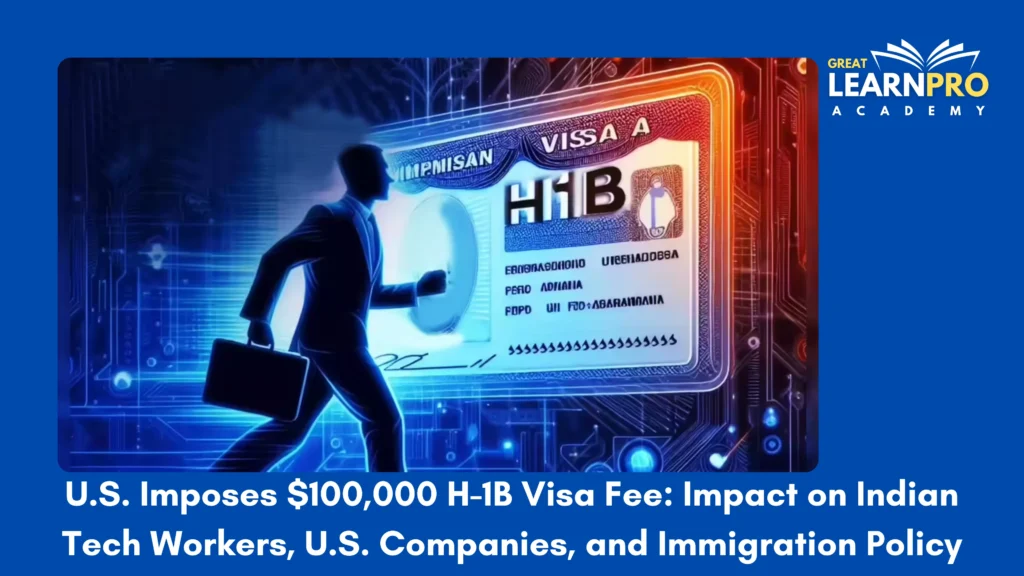In a significant policy shift, the U.S. government has introduced a $100,000 entry fee for new H-1B visa applicants starting September 21, 2025. This move, announced by President Donald Trump, has stirred considerable concern among Indian tech professionals and students, who constitute a substantial portion of H-1B visa holders.

Scope and Applicability of the Fee
The $100,000 fee applies exclusively to new H-1B visa applicants from outside the United States. It does not affect individuals already holding valid H-1B visas or those seeking extensions, transfers, or status changes within the U.S. However, there is ambiguity regarding whether the fee applies to re-entry for current visa holders traveling abroad.
Impact on Indian Tech Professionals
Indian tech professionals are among the most affected by this policy change. Major Indian IT firms, such as Tata Consultancy Services (TCS), Infosys, and Wipro, frequently sponsor H-1B visas for their employees. The new fee could lead to increased operational costs and may deter the hiring of new foreign talent, potentially impacting business operations and profitability.
Reactions from the U.S. Tech Industry
The U.S. tech industry, which heavily relies on the H-1B program to meet its demand for skilled labor, has expressed concerns over the new fee. Companies like Amazon, Microsoft, Meta, and Google, which employ a significant number of H-1B workers, may face increased costs and potential disruptions in their workforce planning. The policy could also discourage international students from pursuing STEM education in the U.S., fearing limited employment opportunities post-graduation.
Potential Shift to Alternative Visa Categories
In response to the new fee, some companies and professionals may consider alternative visa categories, such as the L-1 or O-1 visas. While these visas have their own requirements and limitations, they may offer a more cost-effective option for hiring foreign talent without the $100,000 fee. However, the L-1 visa, in particular, restricts job mobility compared to the H-1B visa, which could affect long-term employment strategies.
Exemptions and National Interest Considerations
The proclamation allows for exemptions to the fee for individuals deemed to serve the national interest. However, the criteria for such exemptions remain undefined, leading to uncertainty among potential applicants and employers. Healthcare workers, such as physical therapists, may qualify for these exemptions, but the lack of clear guidelines complicates planning for affected parties.
Implications for U.S. Immigration Policy
This policy change reflects a broader trend in U.S. immigration policy aimed at prioritizing domestic employment and reducing reliance on foreign labor. While the administration argues that the fee will ensure that only highly skilled individuals who cannot be easily replaced by U.S. workers are admitted, critics contend that it could harm U.S. productivity and economic growth. Economists have warned that the policy may exacerbate brain drain issues by deterring skilled foreign workers and international students from staying in the U.S. after graduation.
Conclusion
The introduction of a $100,000 fee for new H-1B visa applicants marks a significant shift in U.S. immigration policy. While the intent is to encourage domestic hiring and reduce reliance on foreign labor, the policy’s implications for the tech industry, foreign professionals, and the broader economy remain to be fully seen. As the situation develops, stakeholders will need to navigate the evolving landscape to understand and mitigate the impact of these changes.
Sources:
- https://www.reuters.com/world/us/h-1b-visa-what-is-it-who-are-its-beneficiaries-2025-09-22/
- https://www.theguardian.com/business/2025/sep/22/trump-h-1b-visa-fees-us-economy-tech-india
- https://www.businessinsider.com/india-tech-stocks-h1b-visa-application-fee-100000-trump-workers-2025-9
- https://www.washingtonpost.com/business/2025/09/22/trump-h1b-visas-fee/
- https://timesofindia.indiatimes.com/world/us/h-1b-visa-hike-fuels-anxieties-jpmorgan-asked-employees-to-return-to-us-by-september-21-tech-giants-scramble-to-comply-with-100000-visa-fee-increase/articleshow/124049677.cms
More Current affairs: https://learnproacademy.in/updates/
